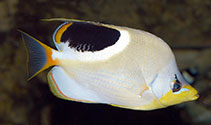| Family: |
Chaetodontidae (Butterflyfishes) |
| Max. size: |
30 cm TL (male/unsexed) |
| Environment: |
reef-associated; marine; depth range 0 - 40 m |
| Distribution: |
Indo-Pacific: Sri Lanka (Ref. 10361) and Cocos-Keeling Islands to the Hawaiian, Marquesan and Tuamoto islands, north to southern Japan, south to Rowley Shoals and New South Wales, Australia. |
| Diagnosis: |
Dorsal spines (total): 12-14; Dorsal soft rays (total): 21-25; Anal spines: 3-3; Anal soft rays: 20-23. Description: Overall color is yellowish grey with a large black spot bordered below by a broad white band on the back, and wavy blue lines on the lower sides. Adults have a filament extending posteriorly from the upper part of the soft portion of the dorsal fin (Ref. 1602). Snout length 2.2-2.6 in HL. Body depth 1.6-1.8 in SL (Ref. 90102). |
| Biology: |
Occur in lagoons and seaward reefs to a depth of 30 m, prefer coral-rich and clear water areas (Ref. 205). Benthopelagic (Ref. 58302). Encountered singly, in pairs or small groups (adults often in pairs; juveniles solitary and inshore). Feed on filamentous algae, small invertebrates, coral polyps, and fish eggs. Oviparous (Ref. 205). Form pairs during breeding (Ref. 205). |
| IUCN Red List Status: |
Least Concern (LC); Date assessed: 08 October 2009 Ref. (130435)
|
| Threat to humans: |
harmless |
Source and more info: www.fishbase.org. For personal, classroom, and other internal use only. Not for publication.

